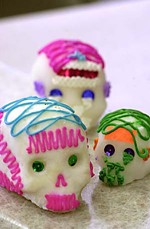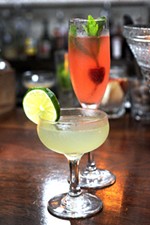Viva la Vida
Exploring Día de los Muertos at Mexic-Arte
By Claudia Alarcón, Fri., Oct. 23, 2009
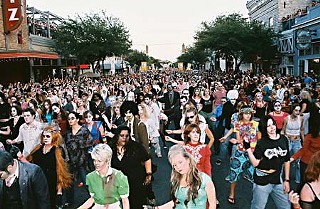
Mexic-Arte Museum has always been at the forefront of local Día de los Muertos celebrations, staging Austin's largest and longest-running Day of the Dead festival for the last 26 years. This year, Mexic-Arte has invited families who have been in Austin for many generations to participate in the community altars exhibition and in the procession as a tribute to their legacies and contributions to making Austin what it is today. The grand celebration includes various events spread out over several days, all open to the public.
As in previous years, the museum will host an exhibition of community altars, contemporary art, and pre-Columbian funeral art from Mexico. The main gallery features traditional and contemporary Día de los Muertos altars created by Austin individuals, schools, and organizations in remembrance of friends, relatives, and heroes.To make the festival eco-friendly, organizers encouraged all participating artists and festivalgoers to work with recycled, reused, and sustainable materials.In keeping with the theme, my husband, artist Will Larson, and I set up an ofrenda in honor of one of our Texas heroes, Lady Bird Johnson, a fervent advocate of native Texas plants. Our altar does include live plants, although, unfortunately, most native Texas plants are not appropriate for indoor living. Instead, I used a few native cactuses and agaves, which we hope will survive the duration of the exhibit, after which they will have a permanent home in my cactus garden. The traditional marigolds and coxcombs used for decoration came from Arnosky Family Farms in Wimberley. The main component of the altar is built of cardboard boxes, and most of the decorative items adorning it are reused.
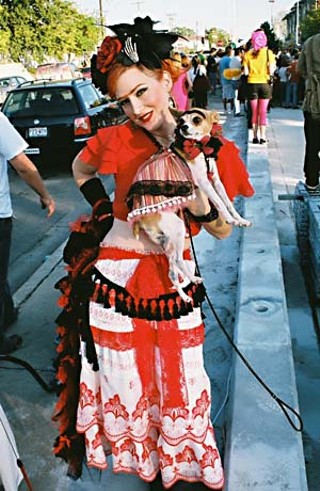
Mexic-Arte Museum employees design and create a main altar each year, highlighting a different region of Mexico. This year, they've chosen to feature the South-Central Mexico state of Puebla. The back gallery showcases Funerary Art of Ancient Western Mexico, featuring fine art replicas of pre-Columbian funerary artifacts from Western Mexico, on loan from the National Autonomous University of Mexico at San Antonio. These exhibits opened Oct. 12 and will be on display until Nov. 22 during regular museum hours.
The main celebration takes place Saturday, Oct. 24. Judging from the turnout over the last 26 years, Austinites have fully embraced the Mexican view that the dead should be celebrated with food, song, and dance. This year's Viva la Vida Fest aims to bring together the Austin community at large to celebrate life and our environment through art and culture.
Activities begin with a discussion and demonstration of the traditional celebratory foods from Puebla by Mexico City native chef Iliana de la Vega, from 11am-1pm. Sponsored by Edible Austin, this presentation will address the history of Día de los Muertos culinarycustoms and how they've evolved into contemporary preparations. Chef de la Vega will also demonstrate how to prepare a traditional mole poblano accompanied by tamales blancos, and samples will be served. De la Vega, who now calls Austin home, is a Mexican cuisine specialist at the Culinary Institute of America – San Antonio and a member of the CIA's Latin Cuisines Advisory Council. Before joining the CIA in 2007, she was the chef/owner of the widely acclaimed El Naranjo Restaurant in Oaxaca City; she's been featured in top U.S. publications includingThe New York Times, Bon Appétit,andCondé Nast Traveler. This lecture is free, but seating is limited; call Mexic-Arte at 480-9373 to reserve a spot.
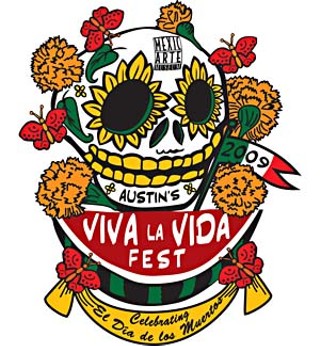
Viva la Vida Fest officially starts at 2pm, featuring hands-on art activities, artist demos, local retail booths, traditional food vendors, and live music and performances, including the ever-popular grand procession. Highlights of last year's procession included the "Thriller" dancers, a mob of zombies who paraded dancing to Michael Jackson's "Thriller," organized by the zany folks at the Alamo Drafthouse. Previous years have seen a procession of 100 Frida Kahlos and a lowrider parade. The festival is free and family-friendly, with hands-on children's activities including altar building, mask painting, paper flower making, and more. Local artists will have booths selling Día de los Muertos-themed arts & crafts, and food vendors will be on hand providing traditional food and drink. This year's vendors include Casa Chapala, La Mexicana Bakery, mmmpanadas, Oaxacan Tamaleo, Rio Grande Mexican Restaurant, Sazón, Los Amigos Club of St. Catherine of Siena, Colibri Aguas Frescas, Co-op Coffee, and Maine Root organic sodas. There will also be a Día de los Muertos Marketplace, a one-stop-shopping hub for traditional ofrenda items such as marigolds, sugar skulls, and other things necessary to create an altar at home or the office.
Of course, it wouldn't be an Austin festival without live music and entertainment. The music lineup includes Last Week Was Better, Manuel "Cowboy" Donley, Mary Welch y Los Curanderos, Tiburon, Peligrosa All-Stars DJs, Bocastria, and Charanga Cakewalk. Performances and entertainment will be provided by Roy Lozano's Ballet Folklorico de Texas, Teatro Vivo, Cine las Americas, St. Edward's University Ballet Folklorico, Los Hijos de Janitzio dance group, and Mexikayotl Children's Folklorico. Other nonprofit organizations will have booths and information available to the public, including Urban Roots, the Austin History Center, ALMA, and the Maya Exploration Center. Part of the proceeds will benefit the museum's education programs.
In keeping with this year's green theme, the museum is committed to leaving a smaller footprint on the environment by reducing waste and minimizing energy consumption. "The event will not only encourage artistic creations," saysPublic Relations and Membership Director Alexandra Landeros, "but will also promote eco-friendly living, healthy eating, and exercise through cycling and walking." A free bicycle valet service will be available on-site, but garage parking is available at the Perry Brooks garage at Ninth and Brazos, the Capitol Tower garage at Ninth and San Jacinto, and the Littlefield garage on Sixth Street, just east of Congress.
Partially fulfilling its mandate to provide cultural programs, Mexic-Arte hosted an educational workshop for teachers at the beginning of the school year, offering a Day of the Dead curriculum package suitable for elementary-school-age children; an activity guide is offered for download at www.mexic-artemuseum.org. As part of this year's education programs, the museum will present a minisymposium on Sunday, Nov. 1, at 2pm, titled Why Do the Dead Come Back? Culture, Life, and Transformation From the Aztec and Maya World Through the Present. The symposium aims to look at both the Day of the Dead event itself and the larger cultural context from an interdisciplinary humanities perspective in order to better understand it. The panelists "will provide the context of daily life in Mesoamerica and how Day of the Dead fits into that cycle of life, explaining why the tradition exists in some places and not others and how we know what [we] know about pre-Columbian history and the cultures within it," according to the website.The symposium will be moderated by Toni Nelson Herrera, education program director at Mexic-Arte, with panelists Enrique Rodríguez-Alegría, assistant professor at the University of Texas, and my friend and colleague Amber O'Connor, a doctoral student in anthropology, also at UT. I will present a short lecture on gastronomic traditions of the Day of the Dead, including a PowerPoint show with original photos from my research and food samples of some of the most representative foodstuffs prepared by chef Marisela Godinez of El Mesón. This program was made possible in part with a grant from Humanities Texas, state affiliate of the National Endowment for the Humanities.
At 26 years, Mexic-Arte's Day of the Dead festival is older than many of Austin's most popular annual culinary arts celebrations. If you've never participated in this fascinating Austin tradition, this is a great year to start!





